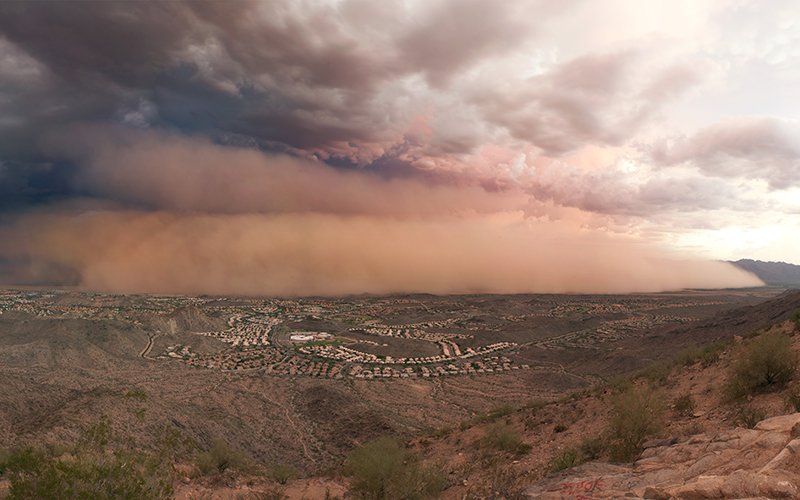Dust storms in Arizona can blow up suddenly, and the patch of desert between Eloy and Picacho Peak is especially prone to wind-driven dust. Dust drastically reduces visibility for drivers, which is why the Arizona Department of Transportation, ahead of monsoon season, has implemented a new dust detection system to protect drivers on Interstate 10 between Phoenix and Tucson.
The roughly $6.5 million technology – the first of its kind in Arizona – uses 13 visibility detectors, a weather radar system, speed sensors and a small weather station, all of which are run through ADOT’s Traffic Operations Center in Phoenix.
Construction began in 2016, and the system became operational in early June after a 30 day test period. Drivers will likely first notice the caution signs alerting them to the changes ahead. Then, electronic speed limit signs are spaced every 1,000 feet and are updated in real time based on weather indicators.
“The idea is that if blowing dust comes along and there is a need to slow the speed limit down to, say 35, then each set of signs can drop it down by 10 miles per hour,” said Garin Groff, a spokesperson for ADOT. “There’s going to be a bunch of them on both sides of the highway.”
The visibility sensors use light beams to check the density of airborne dust and determine the likelihood that a driver could see the road. A 20-foot tower at I-10 and State Route 87 near Eloy is topped by weather radar that detects storms more than 40 miles away.
These technologies help, said Marvin Percha with the National Weather Service in Phoenix, but they don’t replace drivers’ common sense. One of the best things a driver can do, he said, is monitor weather radio or social media for warnings about hazardous conditions. Percha also stressed the need to check the sky and the nearby environment for signs of a storm.
“Certainly if you begin to get visibility that is less than a mile, consider pulling off,” he said. “As they say, ‘Pull aside, stay alive.’”
The dust detection system will operate year round to prevent accidents caused by lack of visibility. In the spring, Arizona commonly experiences another type of blowing dust called dust channels, where strong wind push soil from unplowed fields or open desert.
Dust channels “are actually more dangerous than your classic haboob, which you can see from many miles away, but these dust channels, you can all of a sudden just hit them,” Percha said.
The money for the multimillion dollar system was partly funded by a $54 million federal grant given to ADOT for a series of I-10 projects that included widening the section between Eloy and Picacho.
ADOT hopes the new technology will work as a pilot for future systems to be replicated on other Arizona freeways.
Story by Caitlynn McDaniel, Cronkite News




